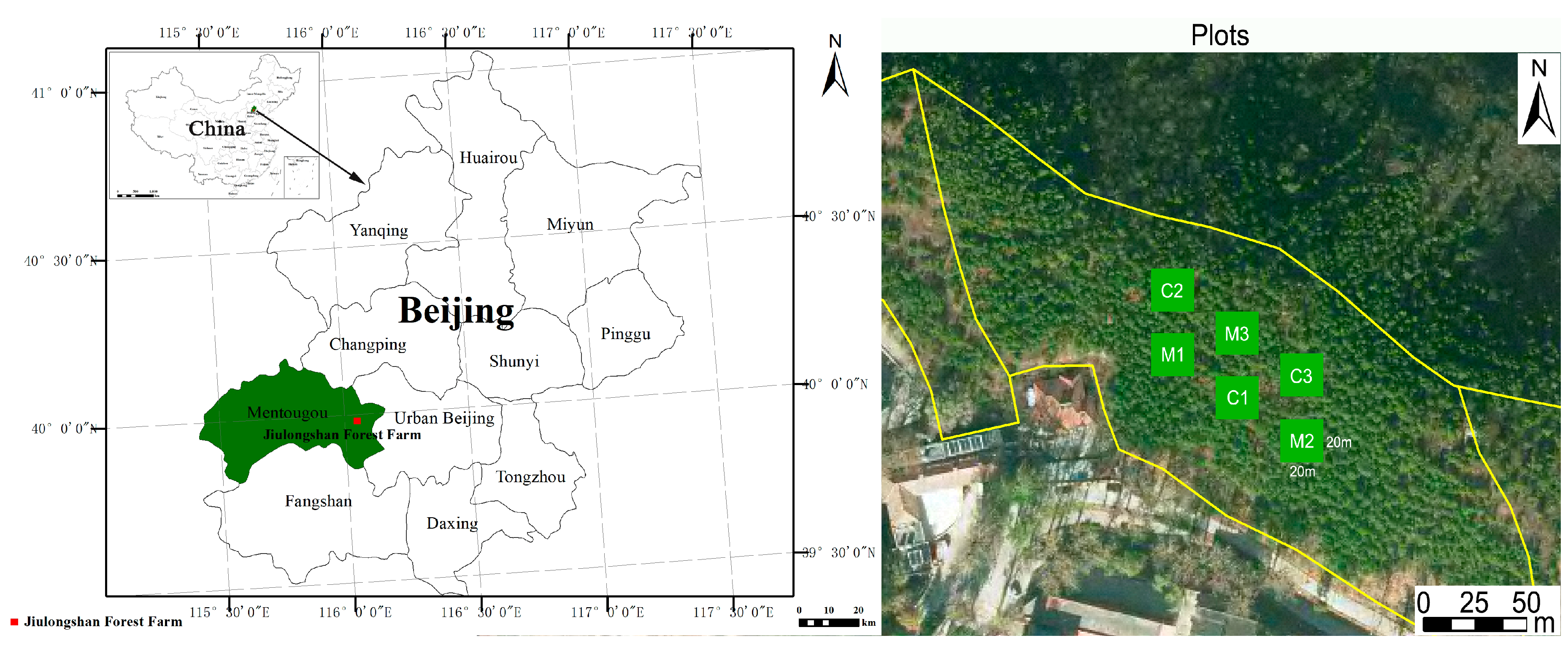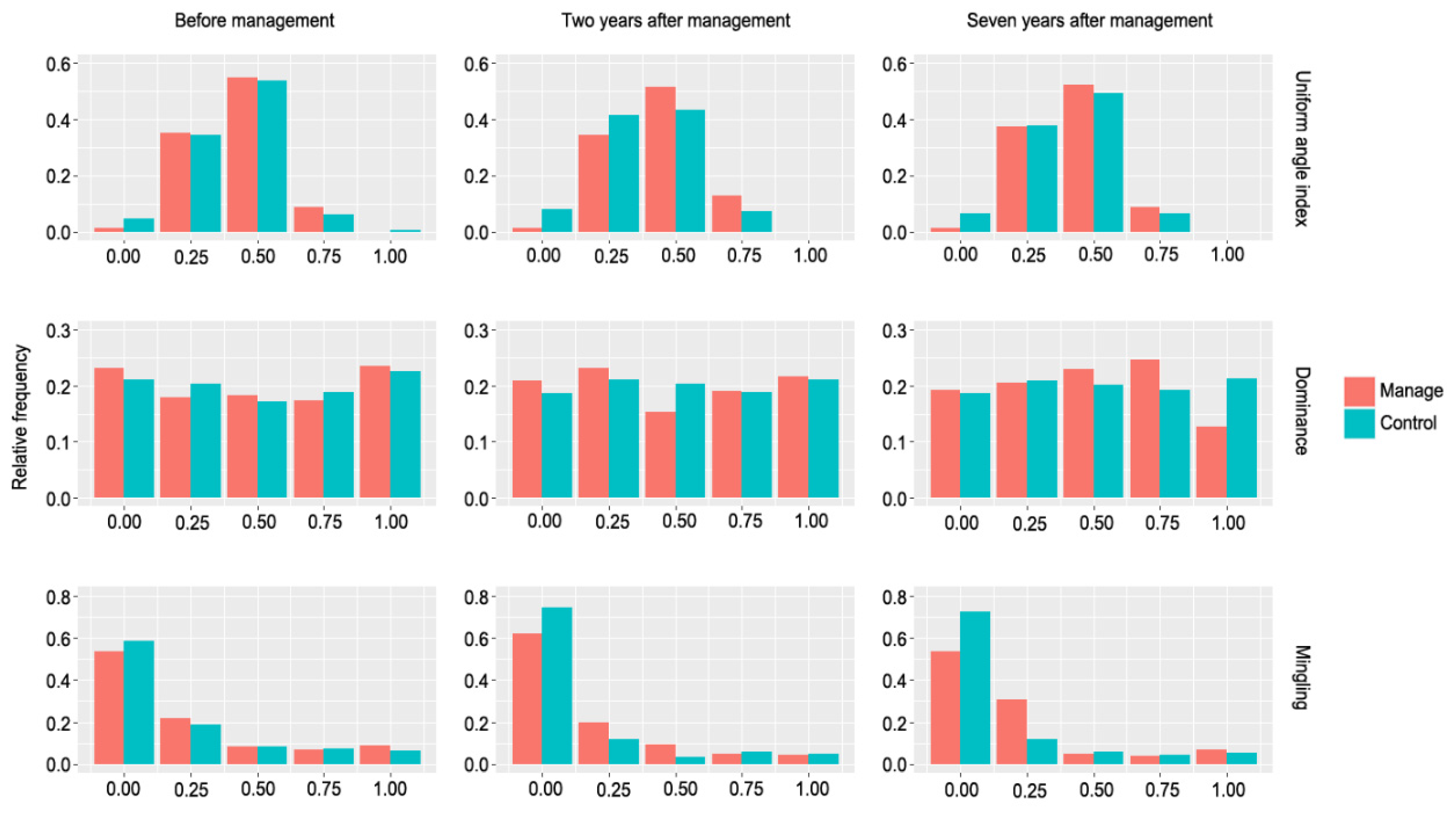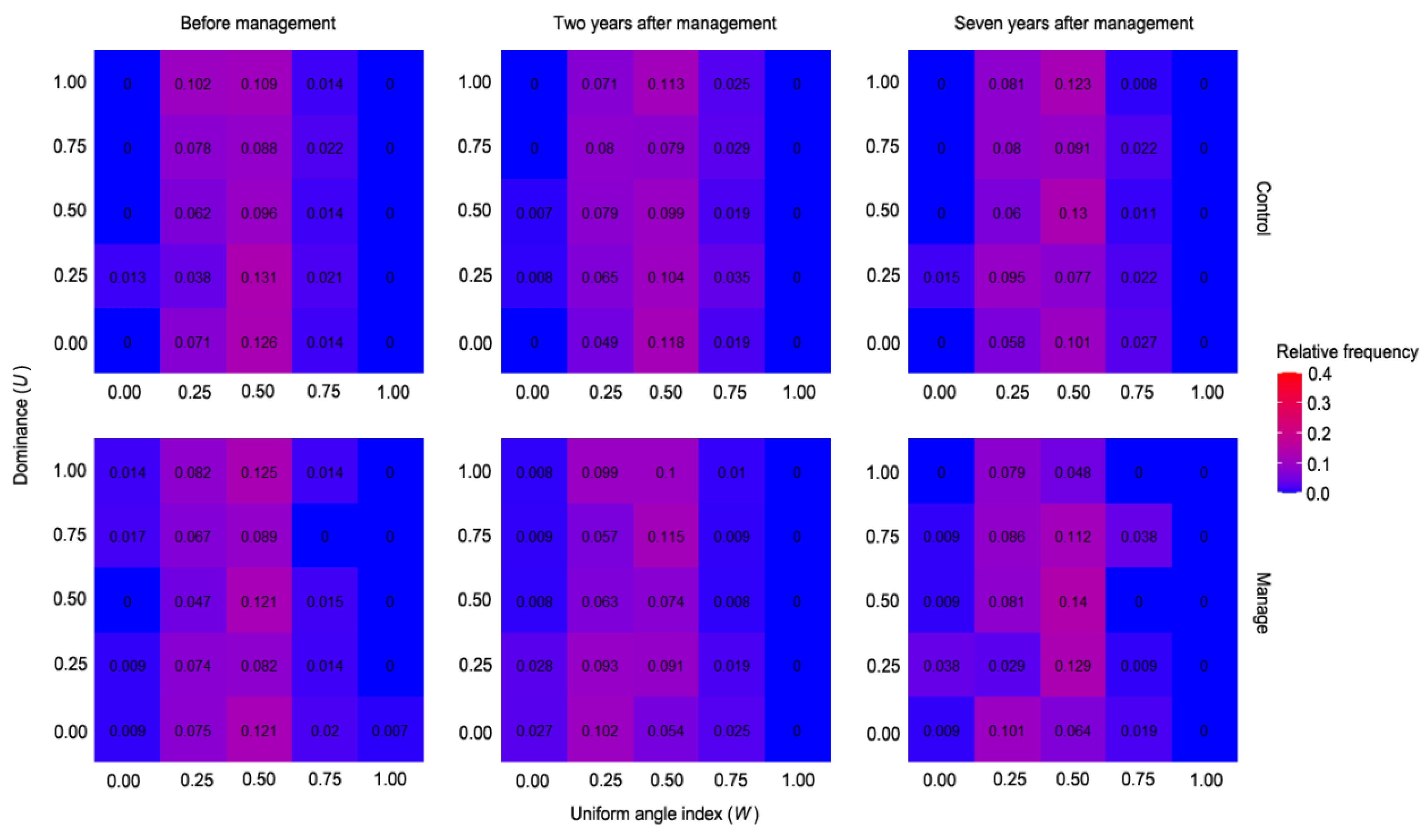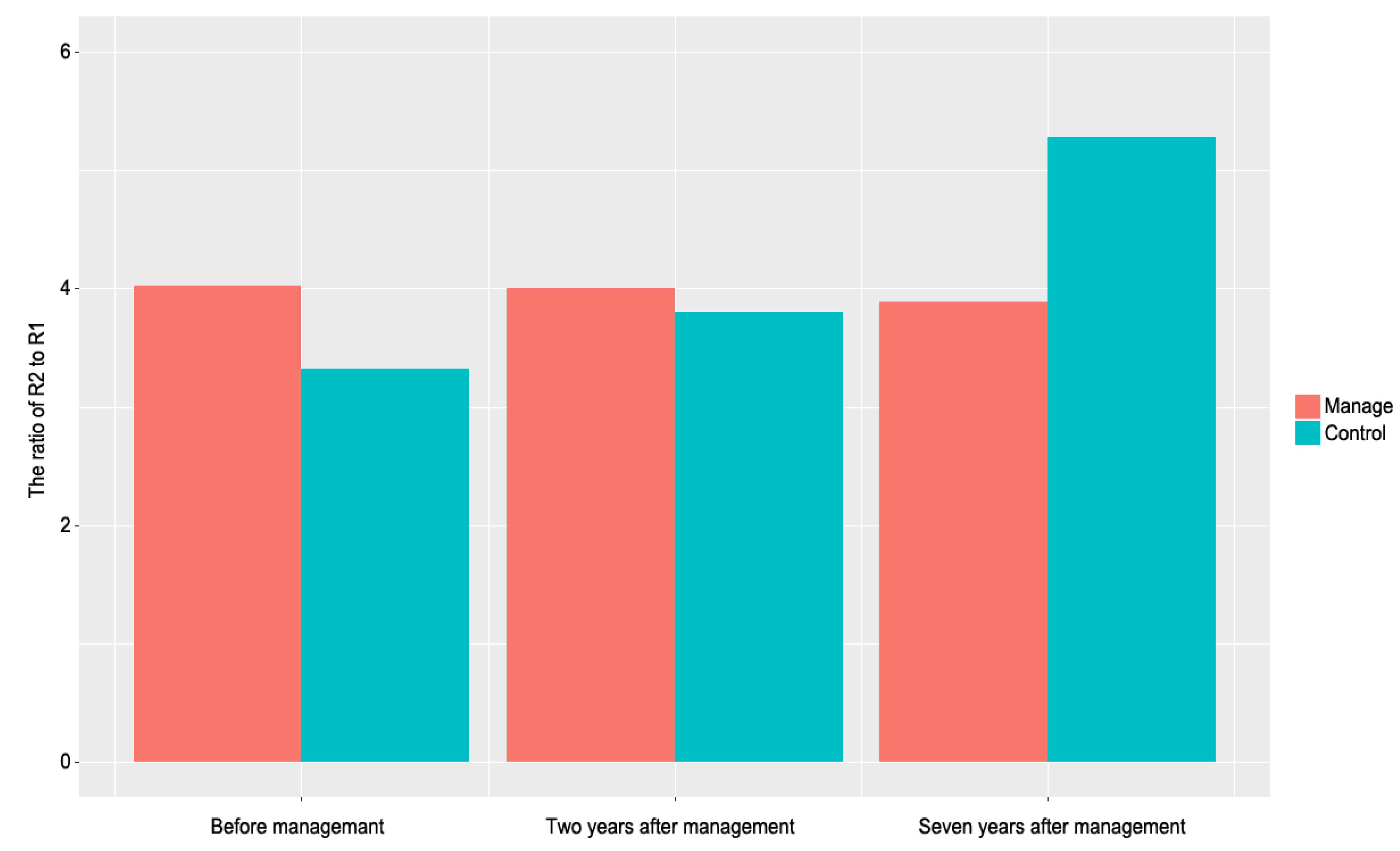Dynamic Effects of Structure-Based Forest Management on Stand Spatial Structure in a Platycladus orientalis Plantation
Abstract
:1. Introduction
2. Materials and Methods
2.1. Study Areas
2.2. Study Site and Data Collection
2.3. Data Analysis
3. Results
3.1. Zero-Variate and Univariate Distributions of SSSPs
3.1.1. Zero-Variate and Univariate Distributions of
3.1.2. Zero-Variate and Univariate Distributions of
3.1.3. Zero-Variate and Univariate Distributions of
3.2. Bivariate Distributions of SSSPs
3.2.1. -
3.2.2. -
3.2.3. -
3.3. Proportions of Different Types of Random Tree
4. Discussion
4.1. Dynamic Changes in Zero-Variate and Univariate Distributions of SSSPs
4.2. Dynamic Changes in Bivariate Distributions of SSSPs
4.3. Dynamic Changes in the Proportions of R1 and R2 Units
5. Conclusions
Author Contributions
Funding
Institutional Review Board Statement
Informed Consent Statement
Data Availability Statement
Conflicts of Interest
References
- Zhang, L.; Hui, G.; Hu, Y.; Zhao, Z. Spatial structural characteristics of forests dominated by Pinus tabulaeformis Carr. PLoS ONE 2018, 13, e0194710. [Google Scholar] [CrossRef] [Green Version]
- Spies, T. Forest structure: A key to the ecosystem. Northwest Sci. 1998, 72, 34–39. [Google Scholar]
- Pommerening, A. Evaluating structural indices by reversing forest structural analysis. For. Ecol. Manag. 2006, 224, 266–277. [Google Scholar] [CrossRef]
- Pretzsch, H.; Zenner, E. Toward managing mixed-species stands: From parametrization to prescription. For. Ecosyst. 2017, 4, 19. [Google Scholar] [CrossRef] [Green Version]
- Hui, G.; Zhang, G.; Zhao, Z.; Yang, A. Methods of forest structure research: A review. Curr. For. Rep. 2019, 5, 142–154. [Google Scholar] [CrossRef]
- Wan, P.; Zhang, G.; Wang, H.; Zhao, Z.; Hu, Y.; Zhang, G.; Hui, G.; Liu, W. Impacts of different forest management methods on the stand spatial structure of a natural Quercus aliena var. acuteserrata forest in Xiaolongshan, China. Ecol. Inform. 2019, 50, 86–94. [Google Scholar] [CrossRef]
- Kint, V.; Meirvenne, M.; Nachtergale, L.; Geudens, G.; Lust, N. Spatial methods for quantifying forest stand structure development: A comparison between nearest-neighbor indices and variogram analysis. For. Sci. 2003, 49, 36–49. [Google Scholar]
- Enquist, B.; West, G.; Brown, J. Extensions and evaluations of a general quantitative theory of forest structure and dynamics. Proc. Natl. Acad. Sci. USA 2009, 106, 7046–7051. [Google Scholar] [CrossRef] [Green Version]
- Pommerening, A.; Meador, A. Tamm review: Tree interactions between myth and reality. For. Ecol. Manag. 2018, 424, 164–176. [Google Scholar] [CrossRef]
- Pommerening, A.; Grabarnik, P. Individual-Based Methods in Forest Ecology and Management; Springer: Cham, Switzerland, 2019. [Google Scholar]
- Gadow, K.; Zhang, C.; Wehenkel, C.; Pommerening, A.; Corral-Rivas, C.; Korol, M. Forest Structure and Diversity. In Continuous Cover Forestry; Gadow, K., Nagel, J., Saborowski, J., Eds.; Springer: Berlin/Heidelberg, Germany; Cham, Switzerland, 2012. [Google Scholar]
- Hui, G.; Zhao, X.; Zhao, Z.; Gadow, K. Evaluating tree species spatial diversity based on neighborhood relationships. For. Sci. 2011, 57, 292–300. [Google Scholar]
- Hui, G.; Wang, Y.; Zhang, G.; Zhao, Z.; Bai, C.; Liu, W. A novel approach for assessing the neighborhood competition in two different aged forests. For. Ecol. Manag. 2018, 422, 49–58. [Google Scholar] [CrossRef]
- Zhang, G.; Hui, G.; Zhang, G.; Zhao, Z.; Hu, Y. Telescope method for characterizing the spatial structure of a pine-oak mixed forest in the Xiaolong Mountains, China. Scand. J. For. Res. 2019, 34, 751–762. [Google Scholar] [CrossRef]
- Li, Y.; Hui, G.; Zhao, Z.; Hu, Y. The bivariate distribution characteristics of spatial structure in natural Korean pine broad-leaved forest. J. Veg. Sci. 2012, 23, 1180–1190. [Google Scholar] [CrossRef]
- Li, Y.; Xu, J.; Wang, H.; Nong, Y.; Sun, G.; Yu, S.; Liao, L.; Ye, S. Long-term effects of thinning and mixing on stand spatial structure: A case study of Chinese fir plantations. Iforest-Biogeo Sci. For. 2021, 14, 113–121. [Google Scholar] [CrossRef]
- Xu, J.; Zhang, G.; Zhao, Z.; Hu, Y.; Liu, W.; Yang, A.; Hui, G. Effects of randomized management on the forest distribution patterns of Larix kaempferi plantation in Xiaolongshan, Gansu Province, China. Forests 2021, 12, 981. [Google Scholar] [CrossRef]
- Dong, L.; Wei, H.; Liu, Z. Optimizing forest spatial structure with neighborhood-based indices: Four case studies from northeast China. Forests 2020, 11, 413. [Google Scholar] [CrossRef] [Green Version]
- Kang, S.; Yang, T.; Zhang, H.; Zhang, L. Dynamic visual simulation of growth and management of Chinese fir based on structured forest management. IOP Conf. Ser. Earth Environ. Sci. 2020, 502, 12038. [Google Scholar] [CrossRef]
- Fang, X.; Tan, W.; Gao, X.; Chai, Z. Close-to-nature management positively improves the spatial structure of Masson pine forest stands. Web Ecol. 2021, 21, 45–54. [Google Scholar] [CrossRef]
- Hui, G.; Gadow, K.; Hu, Y.; Xu, H. Structure-Based Forest Management; China Forestry Press: Beijing, China, 2007. [Google Scholar]
- Hui, G.; Zhao, Z.; Hu, Y. A Guide to Structure-Based Forest Management; China Forestry Press: Beijing, China, 2010. [Google Scholar]
- Hui, G.; Gadow, K. Principles of Structure-Based Forest Management; China Forestry Press: Beijing, China, 2016. [Google Scholar]
- Hui, G. Theory and Practice of Structure-Based Forest Management; Science Press: Beijing, China, 2020. [Google Scholar]
- Bettinger, P.; Tang, M. Tree-level harvest optimization for structure-based forest management based on the species mingling index. Forests 2015, 6, 1121–1144. [Google Scholar] [CrossRef]
- Wan, P.; He, R. Canopy structure and understory light characteristics of a natural Quercus aliena var. acuteserrata forest in China northwest: Influence of different forest management methods. Ecol. Eng. 2020, 153, 105901. [Google Scholar] [CrossRef]
- Dong, M.; Wang, B.; Jiang, Y.; Ding, X. Environmental controls of diurnal and seasonal variations in the stem radius of Platycladus orientalis in northern China. Forests 2019, 10, 784. [Google Scholar] [CrossRef] [Green Version]
- Du, M.; Feng, H.; Zhang, L.; Pei, S.; Wu, D.; Gao, X.; Kong, Q.; Xu, Y.; Xin, X.; Tang, X. Variations in carbon, nitrogen and phosphorus stoichiometry during a growth season within a Platycladus orientalis plantation. Pol. J. Environ. Stud. 2020, 29, 1–12. [Google Scholar] [CrossRef]
- Wang, P.; Jia, L.; Wei, S.; Wang, Q. Analysis of stand spatial structure of Platycladus orientalis recreational forest based on Voronoi diagram method. J. Beijing For. Univ. 2013, 35, 39–44. [Google Scholar]
- Zhang, L.; Sun, C.; Lai, G. Analysis and evaluation of stand spatial structure of Platycladus orientalis ecological forest in Jiulongshan of Beijing. For. Res. 2018, 31, 75–82. [Google Scholar]
- National Forestry and Grassland Administration of China. Report of Forest Resources in China (2014–2018); China Forestry Press: Beijing, China, 2019. [Google Scholar]
- Zhang, L.; Hu, Y.; Zhao, Z.; Sun, C. Spatial structure diversity of Platycladus orientalis plantation in Beijing Jiulong Mountain. Chin. J. Ecol. 2015, 34, 60–69. [Google Scholar]
- Feng, H.; Du, M.; Xin, X.; Gao, X.; Zhang, L.; Kong, Q.; Fa, L.; Wu, D. Seasonal variations in carbon, nitrogen and phosphorus stoichiometry of Platycladus orientalis plantation in the rocky mountainous areas of North China. Acta Ecol. Sin. 2019, 39, 1572–1582. [Google Scholar]
- Liu, Z.; Yu, X.; Jia, G.; Li, H.; Lu, W.; Hou, G. Response to precipitation in water sources for Platycladus orientalis in Beijing mountain area. Sci. Silvae Sin. 2018, 57, 16–23. [Google Scholar]
- Wu, B.; Zhou, L.; Qi, S.; Jin, M.; Lu, J. Effect of habitat factors on the understory plant diversity of Platycladus orientalis plantations in Beijing mountainous areas based on maxent model. Ecol. Indic. 2021, 129, 107917. [Google Scholar] [CrossRef]
- Li, W.; Zhao, X.; Bian, J.; Liu, R.; Ni, R. Regeneration characteristics and spatial pattern of Platycladus orientalis in mount Tai, China. Open J. Ecol. 2021, 11, 276–286. [Google Scholar] [CrossRef]
- Liu, J.; Ha, V.N.; Shen, Z.; Zhu, H.; Zhao, F.; Zhao, Z. Characteristics of bulk and rhizosphere soil microbial community in an ancient Platycladus orientalis forest. Appl. Soil Ecol. 2018, 132, 91–98. [Google Scholar] [CrossRef]
- Wang, P.; Xing, C.; Jia, L.; Wen, J.; Yun, X. Effect of different tending regimes on scenic quality of the Platycladus orientalis recreational forest. Sci. Silvae Sin. 2013, 49, 85–92. [Google Scholar]
- Wang, P.; Jia, L.; Li, X.; Jiang, L. Effect of tending on species composition and diversity of undergrowth in Platycladus orientalis recreational stands. J. Northeast For. Univ. 2012, 40, 78–82. [Google Scholar]
- Duan, J.; Ma, L.; Jia, L.; Jia, Z.; Gong, N.; Che, W. Effect of thinning on Platycladus orientalis plantation and the diversity of undergrowth vegetation. Acta Ecol. Sin. 2010, 30, 1431–1441. [Google Scholar]
- Hui, G.; Gadow, K.; Hu, Y. The optimum standard angle of the uniform angle index. For. Res. 2004, 17, 687–692. [Google Scholar]
- Chai, Z.; Sun, C.; Wang, D.; Liu, W.; Zhang, C. Spatial structure and dynamics of predominant populations in a virgin old-growth oak forest in the Qinling Mountains, China. Scand. J. For. Res. 2016, 32, 19–29. [Google Scholar] [CrossRef]
- Zhang, G.; Hui, G.; Yang, A.; Zhao, Z. A simple and effective approach to quantitatively characterize structural complexity. Sci. Rep. 2021, 11, 1326. [Google Scholar] [CrossRef]
- Hui, G.; Gadow, K. Das Winkelmass—Theoretische Überlegungen zum optimalen Standardwinkel. Allg. Forst Jagdztg. 2002, 173, 173–177. [Google Scholar]
- Wickham, H. ggplot2: Elegant Graphics for Data Analysis; Springer: New York, NY, USA, 2016. [Google Scholar]
- Zhao, Z.; Hui, G.; Hu, Y.; Wang, H.; Zhang, G.; Gadow, K. Testing the significance of different tree spatial distribution patterns based on the uniform angle index. Can. J. For. Res. 2014, 44, 1417–1425. [Google Scholar] [CrossRef]
- Zhang, G.; Hui, G.; Zhao, Z.; Hu, Y.; Wang, H.; Liu, W.; Zang, R. Composition of basal area in natural forests based on the uniform angle index. Ecol. Inf. 2018, 45, 1–8. [Google Scholar] [CrossRef]
- Li, Y.; He, J.; Yu, S.; Wang, H.; Ye, S. Spatial structures of different-sized tree species in a secondary forest in the early succession stage. Eur. J. For. Res. 2020, 139, 709–719. [Google Scholar] [CrossRef]
- Zhang, G.; Hui, G. Random trees are the cornerstones of natural forests. Forests 2021, 12, 1046. [Google Scholar] [CrossRef]
- Cao, X.; Li, J.; Feng, Y.; Hu, Y.; Zhang, C.; Fang, X.; Deng, C. Analysis and evaluation of the stand spatial structure of Cunninghamia lanceolata ecological forest. Sci. Silvae Sin. 2015, 51, 37–48. [Google Scholar]
- Zhao, Z.; Hui, G.; Hu, Y.; Li, Y.; Wang, H. Method and application of stand spatial advantage degree based on the neighborhood comparison. J. Beijing For. Univ. 2014, 36, 78–82. [Google Scholar]
- Aguirre, O.; Hui, G.; Gadow, K.; JimeÂnez, J. An analysis of spatial forest structure using neighborhood-based variables. For. Ecol. Manag. 2003, 183, 37–145. [Google Scholar] [CrossRef]
- Pommerening, A.; Uria-Diez, J. Do large forest trees tend towards high species mingling? Ecol. Inform. 2017, 42, 139–147. [Google Scholar] [CrossRef]
- Li, Y.; Hui, G.; Ye, S.; Hui, G.; Hu, Y.; Zhao, Z. Spatial structure of timber harvested according to structure-based forest management. For. Ecol. Manag. 2014, 322, 106–116. [Google Scholar] [CrossRef]
- Li, Y.; Li, M.; Li, X.; Liu, Z.; Ming, A.; Lan, H.; Ye, S. The abundance and structure of deadwood: A comparison of mixed and thinned Chinese fir plantations. Front. Plant Sci. 2021, 12, 614695. [Google Scholar] [CrossRef]
- Hui, G.; Zhao, Z.; Zhang, G.; Hu, Y. The role of random structural pattern based on uniform angle index in maintaining forest stability. Sci. Silvae Sin. 2021, 57, 23–30. [Google Scholar]







| Management Types | Plots | Stand Density (Tree/ha) | Average DBH (cm) | Average Height (m) | Average Crown Width (m) | Basal Area (m2/ha) |
|---|---|---|---|---|---|---|
| SBFM | M1 | 1317 | 11.78 | 8.08 | 2.39 | 14.34 |
| M2 | 1817 | 10.39 | 7.34 | 2.43 | 15.39 | |
| M3 | 1600 | 10.02 | 7.00 | 2.85 | 12.63 | |
| CK | C1 | 1733 | 9.89 | 6.92 | 2.68 | 13.31 |
| C2 | 1383 | 11.25 | 7.48 | 2.86 | 13.76 | |
| C3 | 1517 | 10.93 | 7.46 | 2.85 | 14.22 |
| Parameters | Before Management | Two Years after Management | Seven Years after Management | |||
|---|---|---|---|---|---|---|
| SBFM | CK | SBFM | CK | SBFM | CK | |
| 0.427 ± 0.01 | 0.409 ± 0.05 | 0.438 ± 0.02 * | 0.374 ± 0.02 | 0.422 ± 0.02 | 0.390 ± 0.04 | |
| 0.500 ± 0.04 | 0.504 ± 0.02 | 0.494 ± 0.04 | 0.506 ± 0.02 | 0.477 ± 0.02 * | 0.512 ± 0.01 | |
| 0.240 ± 0.15 | 0.213 ± 0.11 | 0.174 ± 0.13 | 0.139 ± 0.09 | 0.198 ± 0.12 | 0.147 ± 0.11 | |
| Types | Before Management | Two Years after Management | Seven Years after Management | |||
|---|---|---|---|---|---|---|
| SBFM | CK | SBFM | CK | SBFM | CK | |
| R2 | 0.439 ± 0.13 | 0.383 ± 0.07 | 0.406 ± 0.04 | 0.325 ± 0.08 | 0.405 ± 0.03 | 0.413 ± 0.10 |
| R1 | 0.111 ± 0.02 | 0.155 ± 0.10 | 0.108 ± 0.03 | 0.109 ± 0.05 | 0.118 ± 0.06 | 0.079 ± 0.01 |
Publisher’s Note: MDPI stays neutral with regard to jurisdictional claims in published maps and institutional affiliations. |
© 2022 by the authors. Licensee MDPI, Basel, Switzerland. This article is an open access article distributed under the terms and conditions of the Creative Commons Attribution (CC BY) license (https://creativecommons.org/licenses/by/4.0/).
Share and Cite
Zhang, L.; Feng, H.; Du, M.; Wang, Y.; Lai, G.; Guo, J. Dynamic Effects of Structure-Based Forest Management on Stand Spatial Structure in a Platycladus orientalis Plantation. Forests 2022, 13, 852. https://doi.org/10.3390/f13060852
Zhang L, Feng H, Du M, Wang Y, Lai G, Guo J. Dynamic Effects of Structure-Based Forest Management on Stand Spatial Structure in a Platycladus orientalis Plantation. Forests. 2022; 13(6):852. https://doi.org/10.3390/f13060852
Chicago/Turabian StyleZhang, Lianjin, Huanying Feng, Manyi Du, Yue Wang, Guanghui Lai, and Jia Guo. 2022. "Dynamic Effects of Structure-Based Forest Management on Stand Spatial Structure in a Platycladus orientalis Plantation" Forests 13, no. 6: 852. https://doi.org/10.3390/f13060852
APA StyleZhang, L., Feng, H., Du, M., Wang, Y., Lai, G., & Guo, J. (2022). Dynamic Effects of Structure-Based Forest Management on Stand Spatial Structure in a Platycladus orientalis Plantation. Forests, 13(6), 852. https://doi.org/10.3390/f13060852





